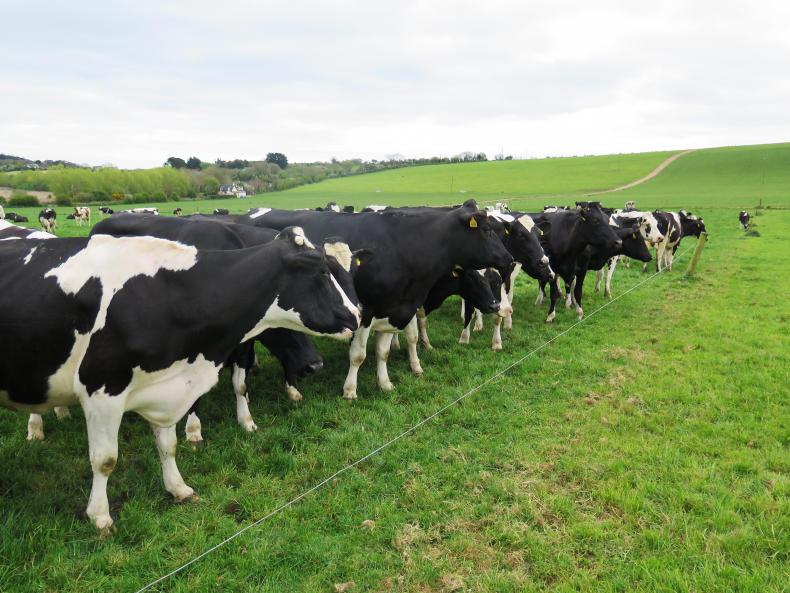Last year wasn’t a great year for Richard Geary – he lost four cows to TB in May and a further 21 in June. By the end of November, a total of 56 cows and two bulls were slaughtered with the disease. This was about one-third of his 160-cow herd.
This year has got off to a much better start. The herd is TB-free, all the cows have calved, 24 new cows were bought and the breeding season started last Monday.
The Geary farm is at Seamount in Carrigaline, south of Cork city, and near the entrance to Cork harbour. The skyline is dominated by the factory buildings of Ireland’s pharmaceutical hub.
Richard is in his third and final year as a Dairygold/Teagasc monitor farmer. He held an open day on the farm last Thursday.
This year, he is milking 170 cows on the 68ha milking platform, which is a stocking rate of 2.5 cows/ha. Last year, despite the setback with TB, the cows milked exceptionally well, producing 520kg of milk solids albeit from 1t of meal per cow.
With a younger herd this year (60% of the herd are in their first and second lactation), Richard is expecting slightly lower performance of between 480kg and 500kg of milk solids per cow. At the moment, the cows are producing 26.2 litres at 3.45% protein and 3.95% fat on 3.2kg of meal.
The focus of the farm walk was on breeding. The Geary herd is all black and white. Average EBI is €106, so is in the top 10% in the country. The breakdown is €29 for milk sub-index and €45 for fertility sub-index.
Teagasc adviser Adrian O’Callaghan went through the strategy used for picking bulls: “There are two things I look at when deciding on what bulls to use on a herd. The first is the EBI report and the second is the co-op performance report. The first tells you the genetic potential of the herd and the second tells you the actual performance of the herd.”
Within the EBI report, Adrian says he looks at the trend in EBI between the different age groups. In Richard’s case, the EBI of the main herd is €106, but the EBI of the first-lactation animals is €121, the EBI of the maiden heifers is €158 and the EBI of this year’s calves is €198. Although the EBI of the herd may drop as a result of the recent changes in EBI, the trend is positive and shows that Richard has been selecting high-EBI bulls.
He said: “I’ve been using high-EBI genomic bulls since 2012. I was never too phased by the fact that they were genomic. I suppose I put faith in the system and it seems to be working so I can’t find fault with it. The figures stack up so I’m happy to continue using genomic bulls even though their EBIs have dropped a bit.”
On his EBI report, the herd’s predicted difference (PD) for fat is 0.10% and the PD for protein is 0.05%. Adrian uses these figures to work out what the genetic potential of the herd is.
Genetic gain
To maximise genetic gain, Richard must select bulls this year that are better than his herd, particularly in solids and fertility. He has picked a team of nine Holstein Friesian bulls for use across the cows and heifers. The average EBI of the team of bulls is €252, with €74 for milk and €127 for fertility sub-index. Only bulls with a calving difficulty of 1.8%, or less, and a reliability of 95% are used on heifers.
Richard started AI last Monday. Why the early start? “We have a dry, early farm here and I can get cows out early. I suppose on 11 or 12 of January, I’d be anxious to get going at calving, to get them out and off, so I start a bit earlier than most. I will do five or six weeks of AI and then do another six weeks with stock bulls,” Richard said.
Cows were tail-painted over the weekend and the plan is that any cow not bulled after 24 days will be scanned by a vet. Last year, 30 cows out of 160 were scanned so the submission rate was 81%. Of these, only four or five cows were actually cycling but had missed heats. The remainder got a shot of prostaglandin or a coil depending on the issue.
Two vasectomised bulls run with the herd after 24 days and these have chin ball markers which helps to identify the cows in heat. The vasectomised bulls run with the heifers before going with the cows.
The maiden heifers will be artificially inseminated to standing heat for six days starting on 21 April. The day after being served, they are sent to the heifer-rearing block where they run with two Angus bulls. Any heifers not yet served are given a shot of PG, four or five at a time over the next week or so. The heifers weighed 323kg on average on 16 March, with the heaviest at 351kg and the lightest at 292kg, so they are well on target.
To work out the genetic potential for protein percentage, you multiply the herd’s PD for protein by 3.5 and add it to the base cow protein of 3.4%. So, in Richard’s case, it is 0.05% multiplied by 3.5, when added to 3.4% is 3.56%. To work it out for fat, multiply the PD for the fat percentage by three and add it to the base cow fat of 3.9%, which in Richard’s case is 4.2%.
Adrian then compares the genetic potential with actual performance. Richard’s 2016 co-op performance report shows that the herd produced 3.62% protein and 4.24% fat, both above the genetic potential showing that management was good. One weakness identified in the co-op performance report is fertility. The six-week calving rate in 2016 was 72% and it was 76% in 2017 while the target is 90%.
